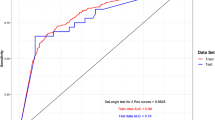Abstract
We aim to describe factors that are associated with kidney stones 20 mm or larger. This information would potentially guide research regarding factors of kidney stone growth. We retrospectively reviewed a patient cohort who underwent surgical treatment for kidney stones. Patients with detailed demographics, 24-h urine testing, and kidney stone profiling were included. Large stone was defined as measuring 20 mm or more. Univariate analysis was conducted to assess variables associated with kidney stones larger than 20 mm. Multivariate logistic regression and statistical machine learning methods were used to infer prediction models. The specific composition of kidney stones, laboratory testing results, and detailed demographics of 277 patients were included in our analysis. Multiple variables were significantly associated with large stones in univariate analysis. The final model that predicts large stone size includes several variables from different domains: hypertension (OR = 1.91; 95% CI 1.06, 3.43), older age (60+ vs 20–40) (OR = 2.46; 95% CI 1.07, 5.63), decreased calcium oxalate supersaturation (OR = 0.92; 95% CI 0.85, 0.99), and higher percentage of protein in stone composition (OR = 5.64; 95% CI 2.04, 15.58). This model yields a sensitivity 83% and specificity of 56%. Models using machine learning algorithms identified similar predictors, but the performance varies. Our model yielded good performance, and it could potentially be used as a clinical tool for predicting large stones and identifying factors affecting kidney stone growth. Similar analysis in other cohorts should be pursued to externally validate findings.
Similar content being viewed by others
References
Chen Z, Prosperi M, Bird VY. Prevalence of kidney stones in the USA: the National Health and Nutrition Evaluation Survey. J Clin Urol. 2018:205141581881382. https://doi.org/10.1177/2051415818813820.
Scales CD, Smith AC, Hanley JM, et al. Prevalence of kidney stones in the United States. Eur Urol. 2012;62:160–5. https://doi.org/10.1016/j.eururo.2012.03.052.
Pearle MS, Goldfarb DS, Assimos DG, et al (2014) AUA guidelines medical management of kidney stones: AUA guideline. https://doi.org/10.1016/j.juro.2014.05.006
Kyriazis I, Panagopoulos V, Kallidonis P, Özsoy M, Vasilas M, Liatsikos E. Complications in percutaneous nephrolithotomy. World J Urol. 2014;33:1069–77. https://doi.org/10.1007/s00345-014-1400-8.
Ahmadi F, Etemadi SM, Lessan-Pezeshki M, Mahdavi-Mazdeh M, Ayati M, Mir A, et al. Contribution of stone size to chronic kidney disease in kidney stone formers. Int J Urol. 2015;22:104–8. https://doi.org/10.1111/iju.12606.
Gettman MT, Segura JW. Management of ureteric stones: issues and controversies. BJU Int. 2005;95(Suppl 2):85–93. https://doi.org/10.1111/j.1464-410X.2005.05206.x.
Burgher A, Beman M, Holtzman JL, Monga M. Progression of nephrolithiasis: long-term outcomes with observation of asymptomatic calculi. J Endourol. 2004;18:534–9. https://doi.org/10.1089/end.2004.18.534.
Goertz JK, Lotterman S. Can the degree of hydronephrosis on ultrasound predict kidney stone size? Am J Emerg Med. 2010;28:813–6. https://doi.org/10.1016/j.ajem.2009.06.028.
Assimos D, Krambeck A, Miller NL, Monga M, Murad MH, Nelson CP, et al. Surgical management of stones: American Urological Association/Endourological Society Guideline, PART I. J Urol. 2016;196:1153–60. https://doi.org/10.1016/j.juro.2016.05.090.
Cohen J, Cohen S, Grasso M. Ureteropyeloscopic treatment of large, complex intrarenal and proximal ureteral calculi. BJU Int. 2013;111:E127–31. https://doi.org/10.1111/j.1464-410X.2012.11352.x.
Quinlan JR (1992) C4.5: programs for machine learning.
Friedman J, Hastie T, Tibshirani R. Additive logistic regression: a statistical view of boosting. Ann Stat. 2000;28:337–407.
Breiman L. Random forests. Mach Learn. 2001;45:5–32. https://doi.org/10.1023/A:1010933404324.
van der Laan MJ, Polley EC, Hubbard AE. Super learner. Stat Appl Genet Mol Biol. 2007;6. https://doi.org/10.2202/1544-6115.1309.
Fawcett T. An introduction to ROC analysis. Pattern Recogn Lett. 2006;27:861–74. https://doi.org/10.1016/j.patrec.2005.10.010.
Nadeau C, Bengio Y. Inference for the generalization error. Mach Learn. 2003;52:239–81. https://doi.org/10.1023/A:1024068626366.
Schisterman EF, Perkins NJ, Liu A, Bondell H. Optimal cut-point and its corresponding Youden index to discriminate individuals using pooled blood samples. Epidemiology. 2005;16:73–81. https://doi.org/10.1097/01.ede.0000147512.81966.ba.
Frank E, Hall MA, Witten IH (2016) The WEKA workbench.
Bird VY, Khan SR. How do stones form? Is unification of theories on stone formation possible? Arch Esp Urol. 2017;70:12–27.
Pramanik R, Asplin JR, Jackson ME, Williams JC. Protein content of human apatite and brushite kidney stones: significant correlation with morphologic measures. Urol Res. 2008;36:251–8. https://doi.org/10.1007/s00240-008-0151-7.
Finkielstein VA, Goldfarb DS. Strategies for preventing calcium oxalate stones. CMAJ. 2006;174:1407–9.
Keller EX, De Coninck V, Audouin M, et al. Stone composition independently predicts stone size in 18,029 spontaneously passed stones. World J Urol. 2019. https://doi.org/10.1007/s00345-018-02627-0.
Author information
Authors and Affiliations
Contributions
Chen: Protocol/project development, data analysis, manuscript writing/editing
Prosperi: Data analysis, manuscript writing/editing
Bird (Vincent): Data collection or management, manuscript writing/editing
Bird (Victoria): Protocol/project development, data collection or management, manuscript writing/editing
Corresponding author
Ethics declarations
Conflict of Interest
The authors declare that they have no conflict of interest.
Ethical Approval
This article does not contain any studies with human participants or animals performed by any of the authors. The analysis was a retrospective analysis, and the study was approved by the University of Florida Institutional Review Board as exempt.
Additional information
Publisher’s Note
Springer Nature remains neutral with regard to jurisdictional claims in published maps and institutional affiliations.
This article is part of the Topical Collection on Medicine
Rights and permissions
About this article
Cite this article
Chen, Z., Prosperi, M., Bird, V.G. et al. Analysis of Factors Associated with Large Kidney Stones: Stone Composition, Comorbid Conditions, and 24-H Urine Parameters—a Machine Learning-Aided Approach. SN Compr. Clin. Med. 1, 597–602 (2019). https://doi.org/10.1007/s42399-019-00087-0
Accepted:
Published:
Issue Date:
DOI: https://doi.org/10.1007/s42399-019-00087-0




